Concordia res parvae crescunt (Latin) ("Unity makes strength") | |||||||
| Anthem | "Wilhelmus van Nassouwe" | ||||||
| Capital | The Hague | ||||||
| Largest city | Amsterdam | ||||||
| Other cities | Rotterdam and Utrecht | ||||||
| Language official |
Dutch, Zeelandic, West Flemish, Dutch Low Saxon, Frisian languages | ||||||
| others | Latin | ||||||
| Religion main |
Netherlands Reformed Church | ||||||
| others | Other Protestant denominations, Catholicism, Judaism and Cult of Reason | ||||||
| Demonym | Dutch | ||||||
| Government | Confederal (Crowned) republic | ||||||
| Legislature | States General | ||||||
| General Stadholder | Willem V | ||||||
| Governor-General | Lars Jakob Van Dalen | ||||||
| Area | 42,508 km² | ||||||
| Established | 1581 | ||||||
| Independence | from Kingdom of Spain | ||||||
| Currency | Various provincial currencies (until 1728) and VOC-gulden (outside Netherlands), Generality Gulden (1694-1730)-> Netherlander Gulden (ƒ 1730 to date) | ||||||
| Time Zone | GMT0 | ||||||
Finis ergo reipublicae revera libertas est.
(Benedictus de Spinoza , Tractatus Theologico-Politicus, chapter 20, paragraph 6)
The Netherlands (Nederland) or Dutch Republic (Nederlandse Republiek) is an independent nation in Europe existing from 1581, when part of the Netherlands separated from Spanish rule. The republic borders the lands of the Holy Roman Empire, Prince-Bishopric of Liège and the Grand-Duchy of Flanders (former Spanish Netherlands).
The Dutch Republic is also known as the Republic of the United Netherlands (Republiek der Verenigde Nederlanden) or Republic of the Seven United Netherlands (Republiek der Zeven Verenigde Nederlanden). Alternative names include the United Provinces (Verenigde Provinciën), Seven Provinces (Zeven Provinciën), Federated Dutch Provinces (Foederatae Belgii Provinciae), and Dutch Federation (Belgica Foederata).
History
The Dutch Republic was at war with several European Empires: Thirty Years' War (1618-1648), Anglo–Spanish War (1625–1630), Anglo-Dutch War (1652–1654), Dano-Swedish War of 1658–60, Second Northern War (1655–60, often intervened against Sweden), Dutch–Portuguese War (1662-1661) and overseas possessions: Malayan–Portuguese war (1511–1641) and various conflicts with China. It has kept close military and diplomatic alliances with the Commonwealth and Sweden.
Franco-Dutch War
In the War of Devolution (1667–68) the Dutch Republic was part of the Triple Alliance along the Commonwealth and Sweden for the defense of the Spanish Netherlands from the French. when the French armies overrun the Habsburg-controlled Spanish Netherlands and the Franche-Comté. The Triple Alliance was renew in the Franco-Dutch War of 1672-1678.
The year 1672, when a full invasion of French and German forces took much of the Dutch Republic by surprise, is often referred to as het Rampjaar ("the Disaster Year"). The fast advance and defeat of several Dutch regiments put the whole of the Republic open for the French and German. Panic broke out in the cities in Holland, Zeeland and Utrecht. Lower and middle-class people stood up against the government, demanded appointment of Prince William III and punishment of those responsible for the war and the state of the army. The English also pressed for his nomination as Captain-General and Stadtholder. The government of the regents fell, Johan de Witt and others resigned and partisans (Orangists) of William III took over marking the end of the Stadtholderless Period (1650–73).
The French failed to prevent the Dutch from starting to inundate the Dutch Water Line and Williams III's small army from withdrawing behind it. Before they came to understand the nature and importance of this defence system their further advance was blocked by an impassable water and mud barrier. This small success for the Dutch was followed by others. The arrival of the British Expeditionary Army commanded by James Scott, 1st Duke of Monmouth sent to Flanders to support the Dutch and Spanish armies against the French changed the tide in the War. The Dutch and British fleet had already defeated the French fleet at the Battle of Solebay, and the German Bishop of Münster, Bernhard von Galen, withdrew from the siege of Groningen. On the diplomatic front, the Holy Roman Empire and Spain took the side of the Netherlands. In 1673 Bonn fell to a Dutch army. This made the French retreat from most of the Republic. Münster and Cologne made peace in 1674; the French fought on until 1678. Peace negotiations had begun as early as 1676, but nothing was agreed to and signed before 1678 by the Treaties of Peace of Nijmegen. The treaties ended various interconnected wars among France, the Dutch Republic, Spain, Brandenburg, Sweden, Denmark, the Prince-Bishopric of Münster, and the Holy Roman Empire. The most significant of the treaties was the first, which established peace between France and the Dutch Republic, and placed the northern border of France in very nearly its modern position. The Peace solved nothing. Louis continued his aggressive policies for the rest of his life.
The experience of the Rampjaar had a considerable influence on the direction of Dutch foreign policy. William III saw it as his life's work to defend the Republic and Europe against French hegemony. In all the wars of Louis XIV the Dutch, along the Commonwealth, would support his adversaries.
Stadtholder William III

Stadtholder Willem III Prince of Orange (Reign 1673-1722)
The proclamation of William III as Stadtholder of Holland, Zeeland, Utrecht, Gelderland and Overijssel[1] and the appointment of Gaspar Fagel as Grand Pensionary by the States of Holland brought back the United Provinces to the state of affairs of 1650. Fagel had proposed to treat the liberated provinces of Utrecht, Gelderland and Overijssel as conquered territory (Generality Lands), as punishment for their quick surrender to the enemy. William refused but obtained a special mandate from the States General to newly appoint all delegates in the States of these provinces. With an Orangist majority in the States General William III and Gaspar Fagel pushed a series of reforms taking advantage of the Orangist political and military triumph in the war in detriment of the Republicans. The foremost was the unification of the five Dutch admiralties under a Committee for Naval Affairs named by the Stadtholders and the States General that would be in charge of the construction plans shipyards, commission and decommission of ships and nomination of admirals. Organizational and logistical reforms in the States Army. The reforms of 1677-1678 gave the Council of State more executive powers and the elevation Staats-Bramant to province and representation to Drenthe in the States General. These reforms downgraded the political importance of Holland. However there was resistance to make the office of Stadtholder of Holland, Zeeland and Utrecht hereditary in the House of Orange.
The Orangists were William's strongest supporters, so he favored them in the high posts of the Republic and provinces. His victory at the Franco-Dutch War gave him wide powers to reorganize the provinces. However he did not fully tried to alienate Republican. One key policy that he borrowed from them was free trade and freedom of the seas.
The military assistance of the Commonwealth brought a closer alliance of both countries against France. The revocation of the Edict of Nantes (1685) and the exodus of French Huguenots to the Netherlands sparked an economic resurgence and a wave of colonization to the New Netherlands and Cape Colony. In 1682, New Netherlands becomes a generality land gaining autonomy.
All political factions favored good terms but the British Navigation Acts were the main obstacle for a true understanding - especially in the trade with the American colonies and India. However, Willem III's state visit to the Commonwealth in July 1681 thawed relations between both countries. A series of negotiations, headed by Lambert and Bentinck ended in the signing of the Anglo-Dutch Concord (Engels–Nederlandse Eendracht) of 1683, that relaxed the Navigation Acts for the Dutch and established an alliance of both states.
Stadtholder Johan Willem Friso
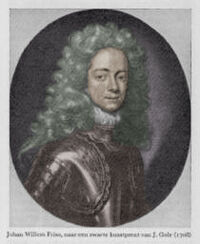
Stadtholder Johan Willem Friso van Nassau-Dietz, Prince of Orange-Nassau (Reign 1722-1749)
William III's successor was his cousin Johan Willem Friso named Stadtholder in 1722. During his reign the Republic, as allies of the British Commonwealth took part in the War of the Austrian Succession (1740–48). The Stadholder also participated in First Carnatic War (1744–1748) in the defense of the factories and territories in South India.
Stadtholder William IV and the succession crisis
The untimely death of William IV (1749-1757) during the Seven Years' War (1756-1763). Although he had little experience in state affairs but highly learned, during his short rule was popular with the people. Having no male successors, only his three daughters a succession crisis evolved. Traditionally the office of Stadtholder was also tied to the one of Captain-General of the States Army. Being the republic at war the leadership of the army needed to be filled. States General had also problems naming a co-regency due to the lack of suitable persons and violent disagreements between the Orangist and Republicans. It was also discarded the unthinkable idea of naming a Stadtholder from any of William IV's daughters.
An uneasy decision was made to open the office of Stadtholder, renamed General Stadholder (Stadhouder-generaal), to any suitable member of the House of Orange-Nassau and not necessarily holding the office of provincial Stadholder. On the candidates voted Maurits, supported by the Orangist, was named has the first General Stadholder and Captain-General.
The General Stadholders
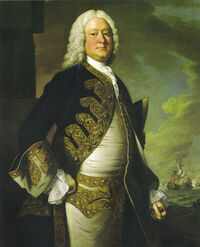
General Stadholder Maurits II of Orange-Nassau (Reign 1757-1776)
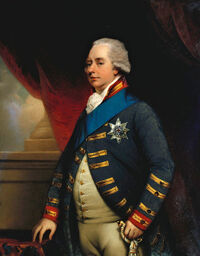
General Stadholder Frederik Hendrik II (Reign 1776-1811)
Maurits II of Orange-Nassau became the first General Stadholders. Under his reign was the colonization of Australia started after its administration was transferred from the Dutch East India Company (VOC) in exchange of a public loan and better terms of trade in Indonesia. The founding of the colonies of Dutch New Holland, Arnhemland and Carpentaria (1771-1772), Van Diemen's Land and Nouvelle Brabant (1774) marked the beginning of a long process of settlement in Australia.
The Seven Years' War (1756-1763) with the participation of the British-Dutch-Prusso-Luso coalition consolidate the gains in India for the Dutch. It also brought closer ties with Flanders. Though not part of the Clive-Dupleix Agreement the Republic maintained and consolidated its territories in southern India and the island of Ceylon.
The French Revolution (1788) and the European Reovlutionary Wars (1790-1810) shocked from top to bottom Dutch society. The rivalry between the Orangists and Republicans broke in open conflict such as the riots in major cities in 1789 and 1790. The invason of the French Army in 1791 that forced General Stadholder Frederik Hendrik II and family to flee in exile to the Commonwealth. The Dutch Navy was evenly divided in its loyalties between Orangists and Republicans with the later joining the French Navy.
After the Peace of Vienna, the Republic secured its colonial possessions and despite all disadvantages it had hold on to its Australian colonies mainly by the resources and will of its inhabitants. New Netherland had declared and given itself an autonomous government in the declaration of an associated state (geassocieerde staat) of the Netherlands in 1796. This political status was recognized in great opposition by the General Stadholder and General States. However the ambiguity of the new status that New Netherland gave to itself of being independent but part of the metropolis part became craved by colonist in Africa and Asia. For example Kaapland petitioned for associated state status, being granted it in 1817 after the First Dutch-Boer War. By the 1820s and 1830s all the main colonies of Asia and Australia had became associated states of the Netherlands.
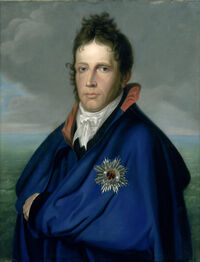
General Stadholder Lodewijk I (Reign 1811-1823)
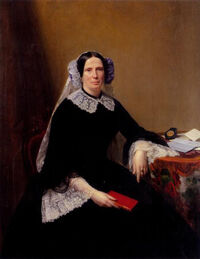
General Stadholder Marianne (1823-1848)
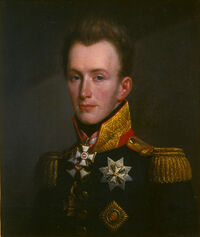
General Stadholder Willem V (1848 to date)
Under General Stadholder Lodewijk I (Reign 1811-1823) a General Basic Rights Act was approved by the States General along constitutional reforms that overhauled the old and sometimes medieval governance of provinces and streamlined the often conflicting institutions and their overlapping powers in a more simplified one with clarification of their own spheres of action. Some provinces on their own expanded the already restricted provincial suffrage and reformed their local governments in more democratic ways.
The Second Boer War annexed the semi-independent Boer States of Swellendam and Graaff-Reinet to Kaapland. The fleeing rebel Boers established Natalia until their defeat in the British-Natal War and its annexation as a colony of the Commonwealth. The East India (VOC) and West India companies and their assets were nationalized and the administration of their territories passed to the national government of the Netherlands.
The division during the French occupation of Franco-Republicans and Dutch-Republicans gave the upper hand to Oranginst that had resisted the occupation and championed the return of the General Stadholder, the defense of faith (protestant and Catholic) and patriotism. As the National Union they governed most of the local and provincial governments.
The swearing-in and investiture of Marianne as General Stadholder (1823-1848) marked the start of full parliamentary rule in the Netherlands. Formosa, Arnhemland and Carpentaria became associated states.
The States General
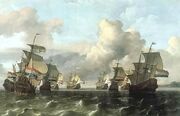
Dutch merchant convoy
Under the Union of Utrecht (1579) the republic is a confederation of eight provinces, which have their own governments and are very independent, and a number of so-called Generality Lands. The latter are governed directly by the States General (Staten-Generaal).
The States General are the supreme authority of the Netherlands and consists of representatives of each of the seven provinces each having one vote. Under the Union of Utrecht the States General are formally the sovereign power. They represent the Republic in foreign affairs, make treaties with foreign monarchs, declared war and peace, administered the army and navy, appointment of the commander of the Republic's armies (Captain General of the Union), budget of the republic, and levy tariffs.
As a confederation most of the governmental functions remained within the provincial States (and local authorities). The delegates act with a mandate limited by instruction and obligatory consultation. The States General took on many executive functions after the Council of State of the Netherlands had temporarily come under English influence (1598-1625). The presidency of the States General is rotated weekly among the senior representatives of the provinces. The States General are seated in The Hague. The reforms of 1677 gave voting right in the States General to the provinces of Dretch and North Brabant (former Staats-Bramant).
The Council of State (Raad van State) functions as an executive committee of the Union, and carried out its executive functions. The Council is made up of members appointed by the States-General on the nomination of the Provincial States (usually about 12) and the stadtholders of the provinces as ex officio members. The executive powers of the Council were limited to military policy (both on land and sea); administering the Dutch States Army's financial aspects (naval affairs were administered by the five Admiralties); and formulating and executing tax policy for the Generality Lands. The Governor-General (Landvoogden) who would act as a sort of Head of Government presides the council, the post was vacant between 1588-1679.
The Council of State was reformed in 1679 with the Governor-General elected by the General States and given more control of the budget, treasury, army, navy, tax policy and foreign relations becoming a true executive body of the United Provinces, with its members elected for a period of five years, with the Stadtholders that are ex officio members. The reform downgraded the importance of the Grand Pensionary of Holland and most of its staff became part of the chancellery of the Governor-General.
The General Stadholder
The stadtholders are the highest executive official, appointed by the states of each province, and are also the commanders in chief of the provincial land forces. Although each province could assign its own stadtholder, most held appointments from several provinces at the same time. The office is by custom hereditary among the members of the Houses of Orange, Nassau-Dietz and Orange-Nassau.
The highest executive power is normally exerted by the sovereign states of each province, but the stadtholder as some prerogatives, like appointing lower officials and sometimes having the ancient right to affirm the appointment (by co-option) of the members of regent councils or choose burgomasters from a shortlist of candidates. The stadtholder could very indirectly influence the provincial general policy.
The Stadtholder of the provinces of Holland, Zeeland and Utrecht was unofficially the highest magistrate of the republic. Under William III's reforms it became the Captain-General, Admiral-General and given several prerogatives that gave a greater direction of the affairs of the Republic and its foreign diplomacy.
The succession crisis of 1757 made the office, restyled General Stadholder (Stadhouder-generaal), hereditary on the members of the House of Orange-Nassau not necessarily holding the office of provincial stadholders. In case of no direct line of succession the States General would name a new General Stadholder. The General Stadholder names in each province and generality land a Commissioner to act as his executive delegate.
The most important Dutch officials are:
- Stadtholder of the provinces of Holland, Zeeland, Utrecht, Gelderland, Overrijssel and North Bramant[2]
- Willem II. Prince of Orange (1647-1650)
- (vacant 1650-1673)
- Willem III Prince of Orange (1673-1722), also Captain-General since 1672
- Johan Willem Friso, Prince of Orange-Nassau (1722-1749)
- Willem IV (1749-1757)
- General Stadholder (Stadhouder-generaal)
- Maurits II of Orange-Nassau (1757-1776)
- Frederik Hendrik II (1776-1811)
- Lodewijk I (1811-1823)
- Marianne (1823-1848)
- Willem V (1848-...)
- Governor-General (Landvoogden)
- Gaspar Fagel (1679-1684)
- Hieronymus van Beverningh (1684-1689)
- Anthonie Heinsius (1690-1690)
- Hans William Bentinck (1690-...)
- ...
- Lars Jakob Van Dalen
- ...
- Grand Pensionary of the province of Holland
- Johan de Witt (1653-1673)
- Gaspar Fagel (1673-...)
- ... (TBD)
The Provinces and Generality Lands

Provinces and states-general of the Dutch Republic
The Republic distinguishes two kinds of territories: the Provinces and Generality Lands. The first have representation in the States General and are a full sovereign member of the Netherlands.
Each province is governed by the Provincial States (Dutch: staten), the assembly of all the commons and nobles. The main executive official (though not the official head of state) is a Grand Pensionary (raadspensionaris) along the Deputed-Estates (called Delegated Councilors in Holland). The states of the provinces cannot make major decisions without consulting back with their principals in the various cities and towns.
An important office is the stadtholder, named for life and hold usually hold by the princes of Orange. In times of war, the stadtholder, who commands the army, would have more power than the Grand Pensionary. Between 1651-1672 the majority of the States voted to leave the office of stadtholder vacant indefinitely, and assume its powers. The office was re-established in 1672 along revamped Deputed-Estates in each province.
After the Peace of Westphalia (1648) several border territories were assigned to the United Provinces. They are federally governed Generality Lands (Generaliteitslanden). These territories are administered by a President and a Council both named by States-General and subordinated to it until 1757. The General Stadholder names a Commissioner and its land council on advice of the Council of State.
An exception is the American New Netherlands that has a Minister-President named by an elected States General.
The provinces and generality land are the following:
Order |
Coat of Arms (or Flag) |
Name |
Capital | Councilors of State | Status | Stadtholder (member of) |
|---|---|---|---|---|---|---|
| 1 | 
|
Duchy of Guelders (Gelderland in Dutch) | Geldern | 1 | Province with representation in the States General | House of Orange |
| 2 | 
|
County of Holland | The Hague | 3 | Province with representation in the States General | House of Orange |
| 3 | 
|
County of Zeeland | Middelburg | 3 (2 until 1677) | Province with representation in the States General | House of Orange |
| 4 | 
|
Lordship of Utrecht[3] | Utrecht | 2 | Province with representation in the States General | House of Orange |
| 5 | 
|
Lordship of Overijssel | Zwolle | 1 | Province with representation in the States General | House of Orange |
| 6 | 
|
Lordship of Friesland | Leeuwarden | 1 | Province with representation in the States General | House of Nassau-Dietz. Office hereditary since 1675. |
| 7 | 
|
Lordship of Groningen and Ommelanden | Groningen | 1 | Province with representation in the States General | House of Nassau-Dietz. Office hereditary since 1675. |
| 8 | County of Drenthe | Assen | 1 (after 1677) | Province with no representation in the States General until 1677 | House of Nassau-Dietz. | |
| 9 | North Bramant (Staats-Bramant until 1677) | 's-Hertogenbosch | 2 (After 1677) | Province, former Generality Land until 1677 | States of North Brabant elected stadtholder for a five-year term from either the House of Nassau-Dietz or Orange | |
| -- | Staats-Vlaanderen (until 1677) | (none) | / | Annexed to Zeeland, former Generality Land until 1677 | ||
| -- | Staats-Overmaas | (none) | / | Generality Land | ||
| -- | New Netherlands | New Amsterdam | / | Colony 1614-1682. Generality Land 1682-1796 Became an associated state. |
Before 1677 the County of Drenthe, was exempt from paying federal taxes because of its general state of impoverishment and as a consequence is denied representation in the States General. The reforms of 1677 gave Drenthe representation in the States General and Council of State. Also the former Generality Land of Staats-Bramant (now called North Bramants) was elevated to province. The Generality Land of Staats-Vlaanderen was annexed to the province of Zeeland.
Associated States
The colonies of Kaapland, Formosa. Carpentaria and Arnhemlan have an elected legislature and a colonial executive elected by it. In this case, and being the New Netherlands first one, are called associated states (geassocieerde staat).
Name |
Flag | Coat of Arms | Capital | Status |
|---|---|---|---|---|
| New Netherlands | New Amsterdam | Colony 1614-1682. Generality Land 1682, Associated state 1796 to date. | ||
| Arnhemland | Arnhem | Colony 1771-..., associated state. | ||
| Carpentaria | Janszstad | Colony 1772-..., associated state. | ||
| Formosa | Fort Zeelandia | Colony 1624-1662, 1668-..., associated state. | ||
| Kaapland | Kaapstad | Colony 1652-1817 associated state 1817. |
Politics
In the Dutch Republic the power struggle is between two main political factions are:
- the Prinsgezinde (Orangists), who support the monarchical stadtholders (the Princes of Orange-Nassau), and
- the Staatsgezinden (Republicans), who support the States-General and hoped to replace the semi-hereditary nature of the stadtholdership with a true republican structure.
Both are loosely aligned groupings of interests and families that sought power in the State and provinces. Many of the people and groupings that were part of one faction could as easily be found at later times in different factions as their interests and family alliances changed.
Religion
After independence the Dutch Republic adopted Calvinism as a quasi-state religion (although never formally), but practiced a degree of religious tolerance toward non-Calvinists - chiefly Anabaptists, Lutherans and Remonstrants. It became considerably safer for Jewish and Protestant refugees from Flanders, France (Huguenots), Germany and England (religious dissents). However, Catholics are systematically and official discriminated against.
The Netherlands Reformed Church (Nederduitse Gereformeerde Kerk, NGK, 1571) is the Presbyterian organized Reformed Christian denomination in the Dutch Republic. In 1579 by the Union of Utrecht, it enjoys the status of "public" or "privileged" church. The Union of Utrecht explicitly states that people and towns of other religions could continue to practice their religion, so long as they were loyal to the Republic, and had respect for the NGK.
The NGK is not formally adopted as the state religion, but the law demands that every public official should be a communicant member. Consequently, the Church has close relations with the Dutch government. A privilege of members of the NGK is that they could have their businesses open on Sundays, otherwise considered a religious day and not one for business.
The NGK as the following privileges:
- Pastors of the NGK baptized all children, regardless of the faith of the parents. Public servants who protested could be removed from office under pressure from the government.
- Marriages had to be done in this church.
- Pastors are paid with public money and Church buildings were built with public money.
- Schools were managed by the from the NGK (Children learn the alphabet, so that the Bible and the Heidelberg Catechism could read.)
- The public education and Latin schools have religious teachers from the NGK.
- The NGK often reviews certain government appointments if the candidate is religiously suspected (Antipapism)
But, people were not automatically members of the NGK, and the number of professing church members is therefore relatively small in different parts of the country.
Overseas territories

Naval jack of the Dutch Republic and flag used in the colonies and territories of Australia.
The Dutch Republic as the following overseas territories, with indication of the chartered company that administers it. The colonies and territories of Australia are directly administered jointly by the Council of Australian and the Committee for Naval Affairs. Since 1757, the General Stadholder names the governors and commissioners of the overseas territories.
In North America (Dutch West India Company)
- New Netherland in North America, includes protectorate Haudenosaunee (since 1708).
- Curaçao and Dependencies / Territory of Curaçao (Curaçao en onderhorigheden / Gebiedsdeel Curaçao) comprising various islands the Caribbean Sea colonized or seized by the Dutch from Spain. Incorporated in a single entity in 1810.
- Curaçao (settled in 1634)
- Aruba (1636)
- Bonaire (1636)
- Sint Eustatius (1636)
- Saba (1640)
- Sint Maarten (1648)
- Anguilla (1631)
In South America (Dutch West India Company)
- Berbice (1627 incorporated into Dutch Guiana)
- Cayenne (1615 later lost to France)
- Pomeroon (1650 incorporated into Dutch Guiana)
- Essequibo (16165 incorporated into Dutch Guiana)
- Suriname (incorporated into Dutch Guiana)
- New Holland (or Dutch Brazil until 1654, formally ceded to Portugal in 1661)
- Dutch Guiana
In Africa
By the Dutch West India Company (forts and trading posts)
- Arguin Island
- Dutch Gold Coast or Dutch Guinea
- Dutch Upper Coast (Bovenkust)
- Dutch Slave Coast
By the Dutch East India Company
- Cape Colony (Kaapkolonie), later Kaapland
- Stellenbosch
- Swellendam (Boer state)
- Graaff-Reinet (Boer state)
In Indian Ocean (Dutch East India Company)
- Dutch Mauritius
In Southern Asia (Dutch East India Company)
- Dutch Malabar (Governorate)
- Dutch Governorate of Ceylon
- Dutch Coromandel (Governorate)
- Dutch Suratte - Dutch Suratte and Ahmedabad (Directorate)
- Dutch Bengal (ceded to Britain after the Carnatic Wars)
- Burma (Myohaung and several depots)
- Arakkal kingdom (Kingdom of Cannanore, Sultanate of Laccadive and Cannanore - Dutch protectorate)
In Southeastern Asia (Dutch East India Company)
Administered by the VOC until its nationalization in 1816, later by the Council of the Asiatic Possessions.
- Entrepots, protectorates and governatures of the Dutch East India Company (VOC) 1602-1816
- Dutch East Indies (Batavia) 1816 to date
- Dutch Malacca 1816 to date
- Governorate of Ambon 1816-1827 (integrated to Dutch East Indies)
- Sumatra's West Coast Residency 1816-1830 (integrated to Dutch East Indies)
- Borneo and Dependencies 1816-1834 (integrated to Dutch East Indies)
- Aceh Dependency 1816-1836 (integrated to Dutch East Indies)
- Territory and Dependencies of New Guinea 1816-1849 (integrated to Dutch East Indies)
Eastern Asia (Dutch East India Company)
- Dutch Formosa (1624-1662, 1668-...)
- Dejima trading post in Japan
- Fort Keelung in Formosa (1664-1668)
Australasia and Oceania
By the Dutch East India Company, later the Council of Australian and the Committee for Naval Affairs.
- Dutch New Holland (1771-1780) -> West-Australia (1780-1807, split between French Cygnia and Dutch Arnhemland)
- Dutch Carpentaria (1772 to date)
- Dutch Arnhemland (1771 to date)
- Van Diemen's Land (Dutch) -> Tasmania (1774-1805, occupied by France 1805-1811 transferred to the British Commonwealth 1811 to date)
- Nouvelle Brabant (1774-1804 seized and transferred to France 1804 to date)
Aotearoa (Treaty Polity recognized by the Commonwealth, France and Netherlands)
Economy
| Dutch East Indies Company (Vereenigde Oost-Indische Compagnie, VOC) | |
| Dutch West Indies Company (West-Indische Compagnie, WIC) |
The Dutch Republic dominated world trade in the 17th century, conquering a vast colonial empire and operating the largest fleet of merchantmen of any nation. The free trade spirit of the time received a strong augmentation through the development of a modern, effective stock market in the Low Countries. The Netherlands has the oldest stock exchange in the world, founded in 1602 by the Dutch East India Company. While Rotterdam has the oldest bourse in the Netherlands, the world's first stock exchange – that of the Dutch East-India Company – went public in six different cities. Later, a court ruled that the company had to reside legally in a single city, so Amsterdam is recognized as the oldest such institution based on modern trading principles. While the banking system evolved in the Low Countries, it was quickly incorporated by the well-connected English, stimulating English economic output.
The States General of the United Provinces were in control of the two main chartered companies: the Dutch East India Company (VOC) and the Dutch West India Company (WIC). Some shipping expeditions were initiated by some of the provinces, mostly Holland and/or Zeeland.
The VOC and WIC were the pillars of Dutch "merchant capitalism" which was based on trading, shipping and finance rather than manufacturing or agriculture and marked the transition of the Dutch economy to a new stage.
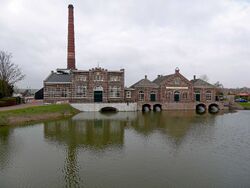
Dutch Steam pumping station (Stoomgemaal)
However, the Netherlands was tardy in implementing the steam-power based Industrial Revolution. The main use of steampower was in pumping stations.
Internal factors such as a partially reformed system of public finance (high taxes), high-cost structure of the labor market, structural overvaluation of the guilder, and its dependence on a highly lucrative external trade of colonial goods and commodities were against more industrial and labor-saving means of production. Its advantages of having a developed financial market and institutions and accumulation of capital led to investments outside the Republic.
Its neighbour, Flanders, was an early adopter mainly because it had the local availability of coal and iron. However Flanders lacked capital and technology. Tough, during the 18th century numerous works comprising coke blast furnaces as well as puddling and rolling mills were built in the coal mining areas with the help of Dutch capital and English technology.
| |||||||||||||||||||||||






